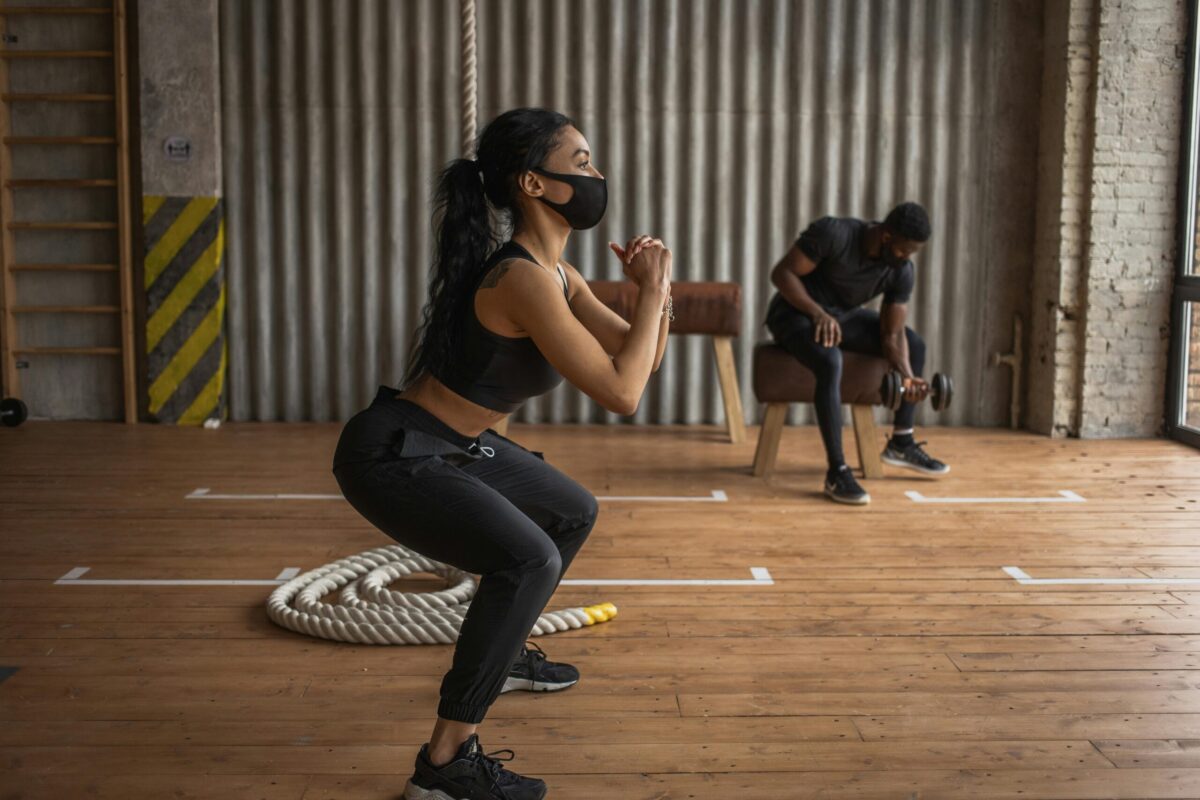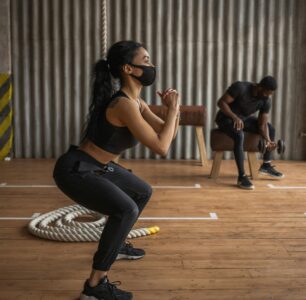Jump squats are a dynamic exercise that can significantly enhance your lower body strength, explosiveness, and overall athletic performance. Whether you’re an athlete looking to improve your vertical jump or someone seeking to enhance your lower body strength, jump squats can be a valuable addition to your workout routine. In this guide, we’ll explore everything you need to know about jump squats, from their benefits to proper execution and variations.
What Muscles Do Jump Squats Target?
Jump squats primarily target the lower body muscles, including:
Quadriceps
The quadriceps, located at the front of the thigh, are heavily engaged during jump squats. They play a crucial role in extending the knee and propelling your body upward during the explosive phase of the movement.
Hamstrings
The hamstrings, situated at the back of the thigh, act as synergists during jump squats, assisting in knee flexion and hip extension.
Glutes
The glutes, comprising the gluteus maximus, medius, and minimus, are activated to stabilize the pelvis and support the explosive upward movement.
Calves
The calf muscles, including the gastrocnemius and soleus, contribute to ankle plantar flexion, helping you push off the ground forcefully.

What Are the Outcomes?
Incorporating jump squats into your workout routine can yield several desirable outcomes:
- Increased Power: Jump squats improve your ability to generate explosive power, which is beneficial for various athletic activities, including sprinting, jumping, and agility-based movements.
- Enhanced Strength: By targeting the lower body muscles, jump squats contribute to greater strength development in the quadriceps, hamstrings, glutes, and calves.
- Improved Athletic Performance: Athletes across different sports, such as basketball, volleyball, and soccer, can benefit from the enhanced agility, speed, and vertical leap achieved through jump squats.
- Calorie Burn: Jump squats are a high-intensity exercise that can elevate your heart rate and burn a significant amount of calories, making them effective for fat loss and cardiovascular health.
How Do They Benefit Rugby Players?
Rugby is a physically demanding sport that requires strength, power, and agility. Jump squats can be particularly advantageous for rugby players by:
- Enhancing Explosiveness: Rugby players need explosive power for actions like sprinting, tackling, and jumping, all of which are improved through jump squats.
- Improving Jumping Ability: Jump squats can help rugby players develop a higher vertical jump, which is crucial for lineouts, catching high kicks, and contesting aerial balls.
- Building Lower Body Strength: Strong legs are essential for rugby players to withstand tackles, maintain stability in scrums, and execute powerful runs. Jump squats strengthen the lower body muscles, enhancing overall performance on the field.
How to Perform the Exercise Correctly
Proper form is crucial for maximizing the effectiveness of jump squats and reducing the risk of injury. Follow these steps to perform jump squats correctly:
- Starting Position: Stand with your feet shoulder-width apart, toes slightly pointed outward. Keep your chest up, shoulders back, and core engaged for stability.
- Squat Down: Lower your body into a squat position by bending your knees and pushing your hips back as if sitting into a chair. Keep your knees in line with your toes, and aim to lower your thighs parallel to the ground.
- Explosive Jump: From the squat position, explosively drive through your heels to jump vertically off the ground. Extend your hips, knees, and ankles simultaneously to propel yourself upward.
- Land Softly: As you descend from the jump, land softly on the balls of your feet, bending your knees to absorb the impact. Maintain balance and control throughout the movement.
- Repeat: Immediately upon landing, descend back into the squat position and explode into the next jump. Aim for a fluid, continuous motion without pausing between repetitions.

Variations of the Exercise
While the basic jump squat is effective on its own, there are several variations you can incorporate to add variety and challenge to your workouts:
- Weighted Jump Squats: Hold a dumbbell, kettlebell, or weight plate at chest level or by your sides to increase resistance and intensity.
- Split Jump Squats: Perform a jump squat while alternating between lunging forward with one foot and then switching to the other foot mid-air.
- Box Jump Squats: Use a sturdy box or platform to perform jump squats, landing softly on the box before stepping or jumping back down.
Integrating the Exercise into Your Routine
To reap the full benefits of jump squats, consider incorporating them into your workout routine in the following ways:
- Warm-Up: Start your workout with a few sets of bodyweight jump squats to activate your lower body muscles and prepare them for more intense exercise.
- Strength Training: Include jump squats as part of your lower body or full-body strength training workouts. Perform multiple sets of 8-12 repetitions with proper form and intensity.
- Plyometric Training: Incorporate jump squats into plyometric circuits or HIIT (high-intensity interval training) sessions to improve power, speed, and cardiovascular fitness.
- Sports-Specific Training: Tailor your jump squat workouts to mimic the movements and demands of your specific sport or activity, whether it’s basketball, soccer, or rugby.
Safety Tips and Common Mistakes
To ensure safety and effectiveness while performing jump squats, keep the following tips in mind:
- Maintain Proper Form: Focus on maintaining a neutral spine, keeping your knees in line with your toes, and landing softly to minimize stress on your joints.
- Start Slowly: If you’re new to jump squats or plyometric exercises, start with low-intensity variations and gradually increase the intensity as your strength and technique improve.
- Avoid Overtraining: While jump squats can be beneficial, avoid overdoing them, especially if you’re experiencing fatigue or soreness. Listen to your body and allow for adequate rest and recovery between workouts.
- Watch for Common Mistakes: Be mindful of common mistakes such as collapsing knees, rounding the back, or allowing the knees to cave inward during the squatting or landing phase.
Complementary Exercises
To complement your jump squat workouts and achieve a well-rounded lower body development, consider incorporating the following exercises:
- Lunges: Lunges target the quadriceps, hamstrings, and glutes while also improving balance and coordination.
- Deadlifts: Deadlifts strengthen the posterior chain muscles, including the hamstrings, glutes, and lower back, which are essential for overall lower body strength and power.
- Calf Raises: Calf raises isolate and strengthen the calf muscles, enhancing ankle stability and explosive push-off power.
- Plyometric Exercises: Include other plyometric exercises such as box jumps, depth jumps, and burpees to further enhance explosive power and agility.
Alternative Exercises
If jump squats aren’t suitable for you due to injury, limitations, or personal preference, consider these alternative exercises:
- Squat Jumps: Similar to jump squats but with a deeper squat position, squat jumps emphasize lower body power and explosiveness.
- Box Squats: Perform squats while using a box or bench to ensure proper depth and form, making it suitable for individuals with mobility issues or those recovering from injury.
- Step-Ups: Step onto a sturdy platform or bench one leg at a time, alternating between legs to target the lower body muscles while improving balance and stability.
By incorporating jump squats into your workout routine and focusing on proper form and technique, you can unlock the benefits of this dynamic exercise and take your lower body strength and power to new heights. Whether you’re an athlete striving for peak performance or a fitness enthusiast seeking to challenge yourself, jump squats offer an effective and versatile solution for achieving your fitness goals.

